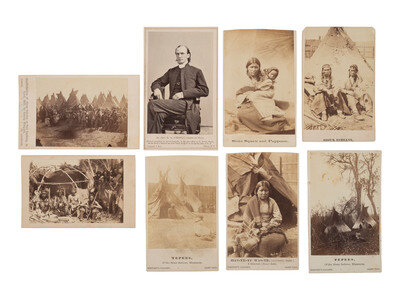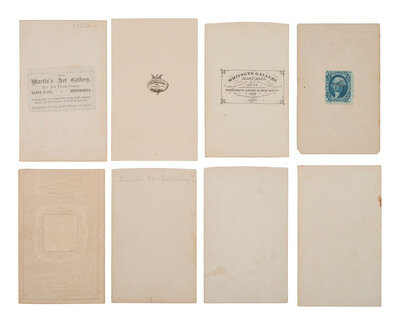Condition Report
Contact Information
Auction Specialist
Lot 227
Sale 6425 - American Historical Ephemera and Early Photography, including The Larry Ness Collection of Native American Photography
Part I - Lots 1-222
Oct 23, 2025
10:00AM ET
Part II - Lots 223-376
Oct 24, 2025
10:00AM ET
Live / Cincinnati
Own a similar item?
Estimate
$1,000 -
1,500
Price Realized
$1,020
Sold prices are inclusive of Buyer’s Premium
Lot Description
A group of 8 CDVs related to the 1862 Dakota Uprising in Minnesota, incl. views of Sioux Indians held at Fort Snelling and Rev. H.B. Whipple.
8 CDVs on cardstock mounts. Scenes and subjects, identified on rectos, include:
"Confirmation of Sioux Indians at Fort Snelling, in April, 1863, by Bishop Whipple." Recto with imprint of Upton, St. Anthony, and verso with applied paper label from Martin's Art Gallery, Saint Paul, MN. Bishop Henry Whipple (1822-1901), a well-known figure in Minnesota history, was elected the state's first Episcopal bishop in 1859. For more than 40 years he built churches and congregations throughout Minnesota. He was a vocal advocate for Indian rights, continually urging decency and honesty in US government policies and treatment of the Dakota. Called "Straight Tongue" by his Indian friends, he can be seen in the center of this photo in clerical garb, ministering to the Dakota. -- "Rt. Rev. H.B. Whipple, Bishop of Minn." Seated portrait of Bishop Whipple, with imprint of Gurney & Son, New York and 1862 date.
The remaining 6 CDVs, which are credited to or attributed to Whitney's Gallery, Saint Paul, MN, were likely taken at the prison camp at Fort Snelling. Subjects include: Winnebago Chief Winneshiek and other Ho-Chunk leaders. -- "Han-Ye-Tu Was-Te" aka Beautiful Night, "A Dakotah (Sioux) Belle" seated before a tent. -- "Sioux Squaw and Pappoose [sic]." -- "Sioux Indians," seated before a tent. -- "Tepees, Of the Sioux Indians, Minnesota" (2), possibly taken inside Fort Snelling.
Together, 8 CDVs.
The new state of Minnesota was home to thousands of Native Americans in 1862, many of whom were disenchanted with the government's promise for annuities. In August of that year, a number of the Dakota were starving; on the 18th, Indians at the Lower Agency attacked the white settlers there. Over the next few weeks hundreds of whites were killed, until the uprising was finally put down by Federal troops under the command of Henry Sibley.
Fort Snelling was used to confine Dakota survivors of the US-Dakota War of 1862 before they were forced to relocate to the Crow Creek Reservation in Dakota Territory, where many died of starvation and disease during the following three years. In 1866, the survivors were moved downriver to Santee, Nebraska, where their descendants remain.
The Larry Ness Collection of Native American Photography
This lot is located in Cincinnati.



